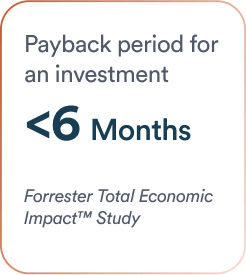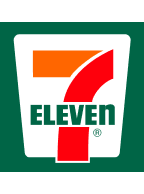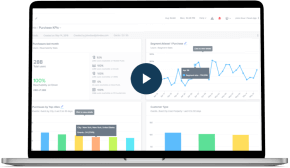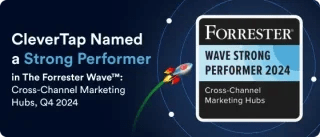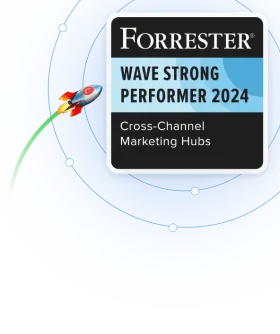RFM customer segmentation—an approach based on recency, frequency, and monetary value—is a powerful framework that helps businesses segment their customers based on recent purchase behaviors, repeat purchase patterns, and overall spending. For e-commerce businesses that grapple with large volumes of customer data, applying RFM analysis can be instrumental in pinpointing high-value segments, refining targeting strategies, and driving conversions.
In this blog, we’ll walk through why RFM segmentation matters in the e-commerce landscape, the main e-commerce segments and relevant, actionable strategies based on CleverTap’s RFM analysis, examples of how leading online businesses leverage RFM segmentation, and discuss common challenges you might encounter when targeting these segments.
Why is RFM Segmentation Important in E-commerce?
RFM segmentation offers numerous benefits to e-commerce businesses by helping them better understand their customers and craft targeted strategies. Here’s why it’s crucial:
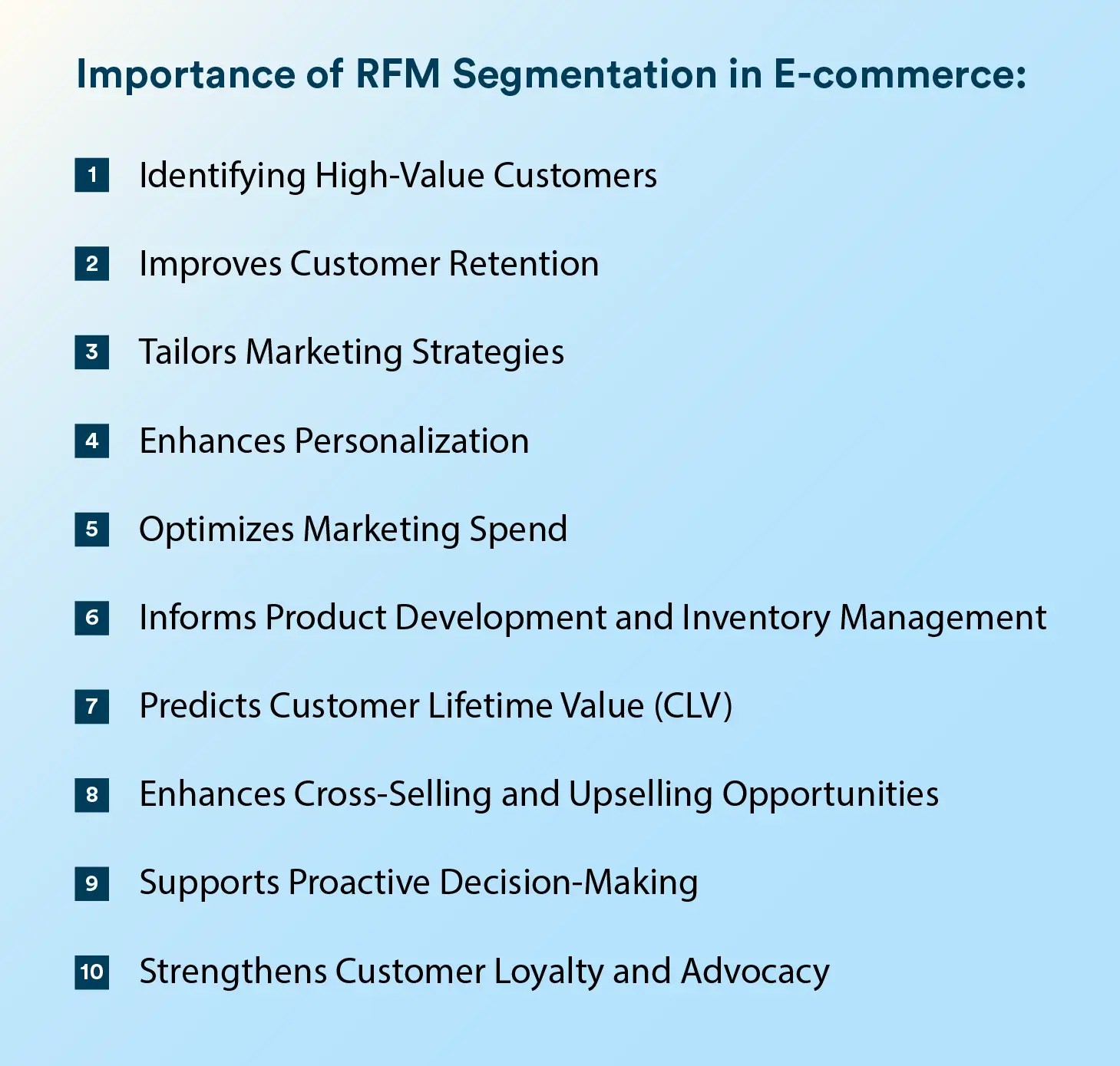
1. Identifies High-Value Customers
By evaluating customer buying behavior across three key dimensions: recency, frequency, and monetary value, RFM segmentation provides a clear picture of your most valuable customers. With this insight, RFM analysis helps you nurture these relationships and allows you to distinguish between one-time buyers and repeat customers, enabling more strategic customer engagement.
2. Improves Customer Retention
RFM segmentation helps you identify which customers are at risk of churning and focus on tailored strategies for retaining them. This proactive approach reduces the churn rate and fosters stronger relationships with the audience.
3. Tailors Marketing Strategies to Different Customer Segments
RFM analysis helps businesses create highly specific customer groups, enabling tailored marketing strategies. For instance, loyal customers with high RFM scores can be targeted with exclusive loyalty rewards, while inactive customers may receive re-engagement campaigns.
4. Enhances Personalization for Better Shopping Experiences
With RFM analysis, you can create tailored messaging that speaks directly to a customer’s buying behavior. Personalization builds trust and improves conversion rates by aligning your marketing efforts with the unique preferences of each customer segment.
5. Optimizes Marketing Spend
One of the biggest challenges in e-commerce is ensuring marketing budgets are allocated effectively. RFM segmentation enables you to prioritize high-value and high-potential customer groups, ensuring your resources aren’t wasted on low-impact audiences.
6. Informs Product Development and Inventory Management
The purchasing patterns uncovered through RFM analysis can reveal valuable insights into which products resonate with your most engaged customers. Understanding which items perform best in different segments can help refine inventory planning, avoid overstocking or understocking, and align your product strategy with customer demand.
7. Predicts Customer Lifetime Value (CLV)
RFM data is a reliable predictor of customer lifetime value because it reflects a customer’s purchasing behavior and potential for future engagement. By analyzing recency and frequency, you can estimate how likely a customer is to remain active, while monetary value gives insight into their overall profitability.
8. Enhances Cross-Selling and Upselling Opportunities
RFM segmentation provides insights into customer preferences, enabling you to craft targeted cross-sell and upsell strategies. These strategies not only enhance the customer experience but also help increase average order value (AOV), driving incremental revenue for your e-commerce business.
9. Supports Proactive Decision-Making
Rather than reacting to declining sales or inactive customers, RFM segmentation empowers you to act proactively. By regularly monitoring customer segments, you can identify emerging trends, such as declining recency scores in previously high-value customers, and take immediate action to address these issues.
10. Strengthens Customer Loyalty and Advocacy
By identifying your most engaged and high-value customers, you can implement strategies that foster deeper brand loyalty, such as loyalty programs, exclusive perks, or personalized appreciation messages. Loyal customers are not only more likely to continue purchasing but also to spread positive word-of-mouth and refer others to your brand.
Understanding RFM E-Commerce Segments to Build Targeting Strategies
RFM analysis groups customers based on their purchasing behavior, enabling businesses to craft strategies for each segment. CleverTap streamlines the analysis using a 2-dimensional graph, created using Recency and Frequency scores.
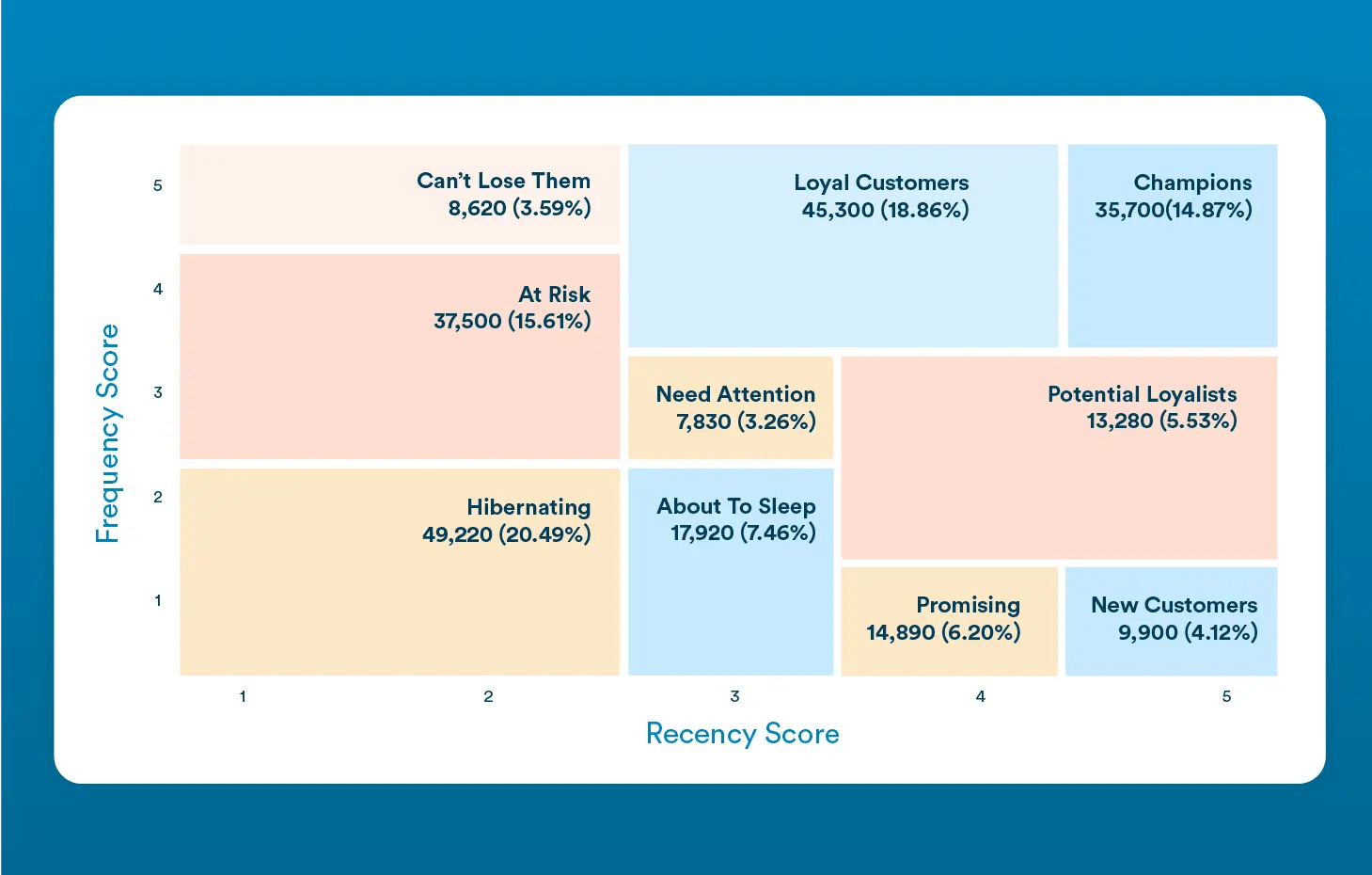
Let’s look at each of these segments and the strategies you can use to target them effectively.
- Champions
These are your most engaged users with the highest recency and frequency scores. They have a strong affinity for your brand and are likely to be long-term customers, making them ideal for loyalty programs and brand advocacy. To boost loyalty, you can:
- Offer exclusive incentives like early access to sales.
- Invite them to referral programs to encourage word-of-mouth marketing.
- Reward them with VIP membership benefits to maintain high engagement.
- Loyal Users
These customers have the highest frequency of interactions and strong recency scores. They engage frequently and have high retention potential. To turn them into Champions, you can:
- Provide them with personalized product recommendations.
- Offer rewards for continued engagement, such as tiered discounts.
- Send exclusive content or early-bird access to keep them engaged.
- Potential Loyalists
These users have visited your site or app recently and show promise of becoming Champions or Loyal Users. To encourage engagement, you can:
- Send personalized welcome offers or first-time purchase discounts.
- Educate them on the value of long-term engagement through targeted content.
- Nurture them with automated follow-ups showcasing best-selling products.
- New Users
These are your most recent users with low-frequency scores. Encouraging repeat use is crucial for retention. For this, you can consider the following strategies:
- Guide them through an engaging onboarding experience.
- Offer a discount or incentive on their next purchase.
- Introduce them to your best-selling products or categories to build interest.
- Promising Users
These users have high recency scores and have the potential to become high-frequency users. To encourage frequent engagement, you can:
- Keep them engaged with personalized recommendations.
- Offer limited-time promotions to encourage frequent purchases.
- Use gamification strategies to keep them actively participating.
- Needing Attention
These users have above-average recency and frequency scores but need a push to stay engaged. You can boost engagement by:
- Reminding them of their recent activity and suggesting similar products.
- Providing limited-time discounts to encourage another purchase.
- Sending customized push notifications highlighting their browsing history.
- About to Sleep
These customers have below-average recency and frequency scores and may slip away if not engaged. You can keep them engaged by:
- Sending reminder emails with special incentives.
- Highlighting new arrivals or best-selling products.
- Offering personalized recommendations based on past purchases.
- At Risk
These users were once frequent customers (above-average frequency) but haven’t engaged recently (low recency). To re-engage them, you can:
- Use win-back campaigns with time-sensitive offers.
- Offer free shipping or loyalty points to incentivize return visits.
- Conduct surveys to understand why they dropped off and tailor retention strategies.
- Cannot Lose Them
These were once active users but haven’t returned recently. They are high-value customers worth reactivating. This can be achieved by:
- Offering them VIP reactivation perks.
- Sending highly personalized win-back messages with an incentive.
- Providing them with an exclusive, time-limited offer to rekindle their interest.
- Hibernating Users
These users have the lowest recency and frequency scores and may be lost permanently. To win them back, you can:
- Use last-attempt win-back offers with significant discounts.
- Test different messaging and incentives to gauge reactivation potential.
- Encourage them to provide feedback on why they disengaged.
You Might Like to Read: What is RFM Analysis? Calculating RFM Score for Customer Segmentation
Examples of RFM Segmentation from E-Commerce Businesses
CleverTap has helped several e-commerce companies globally to leverage RFM analysis. Let’s look at some of these implementations.
Black Friday FM
Holiday deals app Black Friday FM, with over 11 million users, was finding it difficult to personalize engagement strategy that used in-app behavior to send custom notifications based on a user’s browsing history. It was able to overcome this challenge using CleverTap’s RFM Analysis which enabled it to quickly and easily segment and engage each of its users with perfectly personalized messages.
Explore how Black Friday achieved a 10% jump in app engagement with CleverTap. Read the Black Friday case study.
Tata CLiQ Luxury
Tata CLiQ Luxury, an India-based premier luxury lifestyle platform, was struggling to understand user intent and implement real-time, intelligent campaigns. With CleverTap, it segmented its user base into 10 categories based on RFM analysis. This segmentation helped them identify Champions, Loyal Users, New Users, Hibernating Users, and other segments, enabling them to craft the right messaging strategy for each of the segments.
Learn how CleverTap helped Tata CLiQ Luxury boost revenue by 159%. Read the Tata CLiQ Luxury case study.
Challenges in Targeting RFM E-Commerce Segments
While RFM segmentation is highly effective, it’s not without challenges. Here are some pitfalls and how to address them:
- Data Accuracy and Completeness
Inconsistent or fragmented data can skew recency, frequency, or monetary metrics. Brands need to invest in integrated customer data platforms (CDPs) or robust analytics tools that unify data. Regularly performing data hygiene tasks helps remove duplicates and update fields.
- Over-Segmentation Leading to Complexity
Creating too many micro-segments can lead to overly complex marketing campaigns, diminishing returns, and operational hassles. Businesses should start with a manageable number of segments (e.g., 5–8) and then scale their segmentation approach as their marketing team and automation tools become more advanced.
- Operational Constraints
Even if the RFM scores are accurate, implementing segmented campaigns requires cross-functional coordination—CRM, marketing automation, creative resources, and others. Businesses can overcome this challenge by employing a phased approach — targeting one or two high-value segments with clear campaigns, gathering insights, optimizing, and then rolling out to additional segments.
- Lack of Personalization Beyond RFM
RFM alone might not account for nuanced shopper interests—such as category preferences, browsing behavior, or brand affinity. It is crucial to supplement RFM with other data points like product category interests, browsing patterns, or demographic insights.
- Customer Privacy and Compliance
Collecting and leveraging customer data falls under regulations like the GDPR, CCPA, and other privacy laws. Brands must ensure they have transparent privacy policies, clear consent mechanisms, and data-protection strategies in place.
How CleverTap’s RFM Analysis Helps E-commerce Companies
CleverTap’s RFM analysis helps e-commerce companies implement data-driven marketing strategies that enhance customer retention, increase revenue, and optimize their engagement efforts.
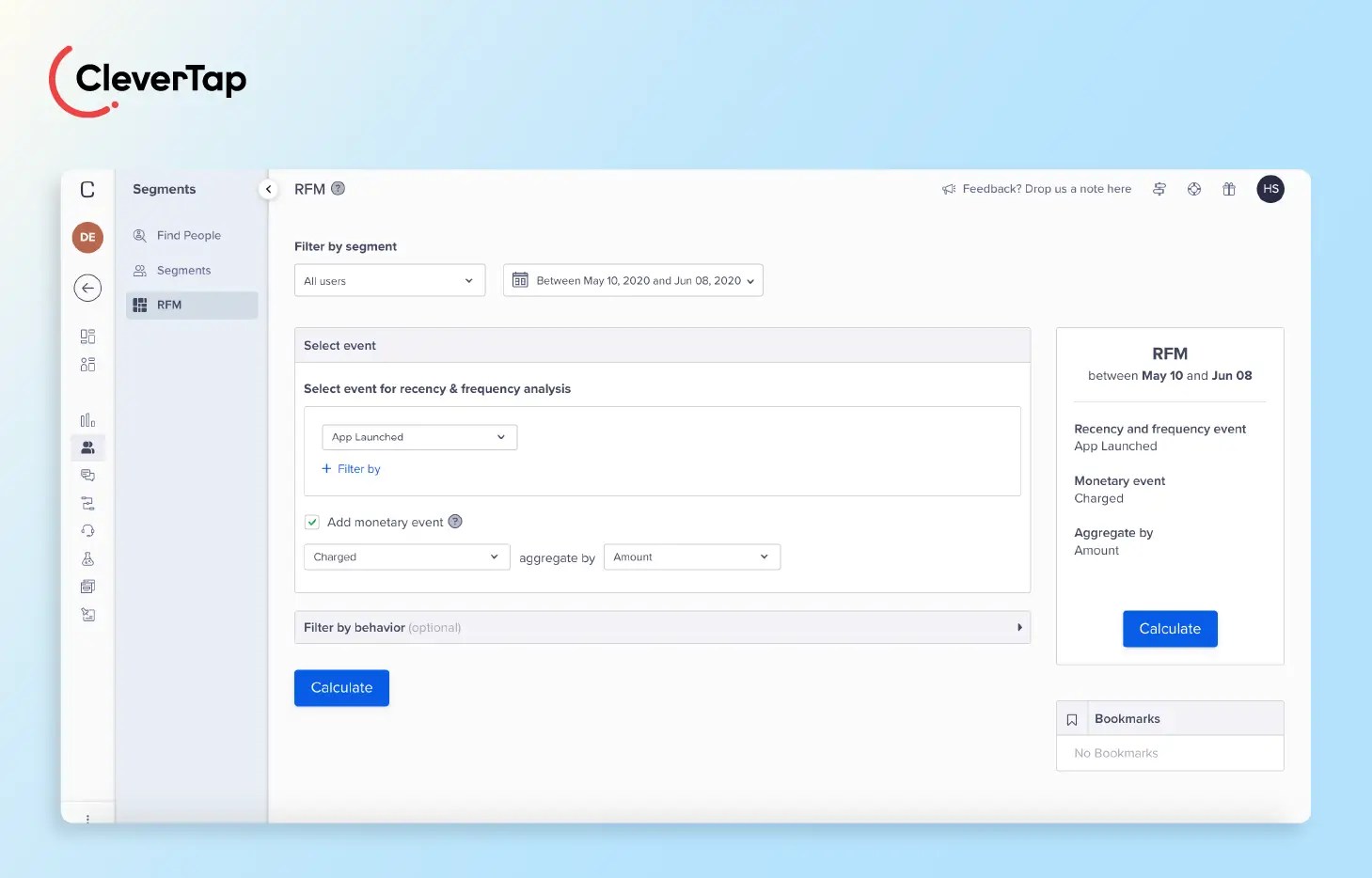
It empowers brands to:
- Automate Segmentation
CleverTap automatically segments users into 10 unique categories based on how recently and frequently they performed an event, such as making a purchase. This helps businesses create targeted campaigns efficiently for each of the segments.
- Detect At-Risk Customers and Reduce Churn
RFM Grid, a powerful visualization tool of the RFM Analysis feature, provides actionable insights into customers who are becoming inactive or at risk of churning. It enables businesses to launch re-engagement campaigns with discounts, personalized offers, or reminders.
- Optimize Customer Lifecycle Marketing
Using RFM Transition, businesses can easily understand the flow of their users from one RFM segment to another. It helps them design customer lifecycle campaigns that encourage movement from one stage to another, such as from a “Potential Loyalist” to a “Loyal Customer.”
- Gain Channel-Specific Insights
CleverTap provides channel-specific reachability metrics for RFM segments, enabling marketers to understand which channels are most effective for each customer segment.
- Drive Repeat Purchases and Upsells
Using RFM analysis, businesses are able to easily identify the best opportunities for upselling and cross-selling to high-value customers. They are better equipped to encourage repeat purchases by targeting users with exclusive offers and product recommendations.
- Track and Measure Campaign Impact
CleverTap allows businesses to track how users move between RFM segments over time. This enables them to measure the effectiveness of marketing campaigns and refine strategies accordingly.
Maximizing E-Commerce Growth with RFM Segmentation
RFM analysis provides a straightforward yet invaluable lens through which e-commerce businesses can view their customers’ purchasing behavior. It helps pinpoint strategic avenues for upselling, cross-selling, re-engagement, and loyalty-building campaigns. When combined with other personalization tactics and robust technology tools, RFM analysis can significantly elevate your e-commerce brand’s customer engagement and, ultimately, your bottom line.

Ready to see how CleverTap RFM segmentation can elevate your marketing efforts?
Subharun Mukherjee 
Heads Cross-Functional Marketing.Expert in SaaS Product Marketing, CX & GTM strategies.
Free Customer Engagement Guides
Join our newsletter for actionable tips and proven strategies to grow your business and engage your customers.



